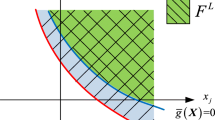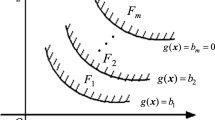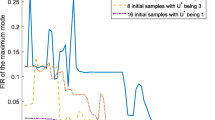Abstract
Metamodel-based approaches to reliability analysis, e.g., adaptive Kriging, are computationally challenged by the complexity of reliability problems, thus limiting the application of these methods to problems that are low-dimensional or not rare. Here, we propose a reliability analysis approach via a deep integration of subset simulation and adaptive kriging (RASA) for an unbiased estimation of failure probabilities of high-dimensional or rare event problems. Concepts of conditional failure probability curves and dynamic learning function are introduced to decompose the original problem to subreliability problems and adaptively identify intermediate failure thresholds of limit state functions corresponding to the subreliability problems. The reliability decomposition and the establishment of target intermediate failure thresholds are guided by the available computational capacity, thus, enabling RASA to control the computational cost associated with the estimation of the intermediate failure thresholds in each subset and consequently to analyze the reliability of medium to high-dimensional problems or rare events. Three numerical examples are investigated as benchmark to explore the performance of the proposed method. Results indicate that the proposed method has high accuracy and has the ability to adjust to available computational resources.













Similar content being viewed by others
Abbreviations
-
 :
: -
Function of the computational capacity
- C r :
-
Required computational storage
- \( {COV}_{{\hat{P}}_f^{mcs}} \) :
-
Coefficient of variation of \( {\hat{P}}_f^{mcs} \)
- \( {COV}_{{\hat{P}}_f^{ss}} \) :
-
Coefficient of variation of \( {\hat{P}}_f^{ss} \)
- COV thr :
-
Coefficient of variation of \( {\hat{P}}_f^{mcs} \)
- f :
-
The Kriging basis function
- F :
-
The vector of f
- g :
-
True limit state function
- \( \hat{g} \) :
-
Estimated limit state function
- g i :
-
True sub-limit state function in SS
- \( {\hat{g}}_i \) :
-
Estimated sub-limit state function in SS
- I g :
-
Indicator based on g
- \( {I}_{\hat{g}}^{si} \) :
-
Indicator based on \( \hat{g} \)
- m :
-
Number of samples for Kriging training
- n ss :
-
Number of subsets
- N cds :
-
Number of candidate design samples for any algorithm
- N d :
-
Number of the dimension of random variables
- N MCS :
-
Number of samples for MCS
- N ss :
-
Number of candidate design samples in SS
- \( {N}_{ss}^{max} \) :
-
Maximum number of candidate design samples in Kriging-based SS
-
 :
: -
Parameter sets for Kriging surrogate model
- p 0 :
-
Intermediate probability of failure
- \( {p}_0^{\ast } \) :
-
Optimal intermediate probability of failure
- P f :
-
Probability of failure (ground truth)
- \( {\hat{P}}_f^{di} \) :
-
Probability of failure estimated with deterministic indicator
- \( {P}_f^{mcs} \) :
-
Probability of failure estimated through MCS
- \( {\hat{P}}_f^{mcs} \) :
-
Probability of failure estimated through Kriging-based MCS
- \( {\hat{P}}_f^{si} \) :
-
Probability of failure estimated with stochastic indicator
- \( {P}_f^{ss} \) :
-
Probability of failure estimated with SS
- \( {\hat{P}}_f^{ss} \) :
-
Probability of failure estimated through Kriging-based SS
- p k :
-
Intermediate failure probability for SS
- \( {\hat{p}}_k \) :
-
Intermediate failure probability for Kriging-based SS
- r :
-
Correlation vector
- R :
-
The Kriging correlation function between two points
- S :
-
Pool of generated samples in Ωf
- t i :
-
True intermediate failure thresholds
- \( {\hat{t}}_{\boldsymbol{i}} \) :
-
Estimated intermediate failure thresholds
- x :
-
The vector of random variables
- x tr :
-
Training samples
- \( {\boldsymbol{x}}_{tr}^{\ast } \) :
-
Next best training samples
- Y :
-
Vector of the responses from Kriging
- Z :
-
The Gaussian process
- β :
-
The vector of coefficients for Kriging basis
- Γ thr :
-
Stopping criterion threshold
- θ :
-
The vector of hyperparameters for Kriging
- Θ t :
-
pdf of identified intermediate failure thresholds
- \( {\mu}_{\hat{g}} \) :
-
The mean value of Kriging responses
- ρ :
-
Probability density function (pdf)
- σ 2 :
-
Variance of Gaussian process
- \( {\sigma}_{\hat{g}}^2 \) :
-
The variance of Kriging responses
- φ :
-
pdf of Gaussian distribution
- Φ:
-
cdf of Gaussian distribution
- Ω:
-
Probabilistic domain of x
- Ωf :
-
Failure domain of Ω
- Ω i :
-
The ith subsets in subset simulation
- Ωs :
-
Failure domain of Ω
References
Au S-K, Beck JL (2001) Estimation of small failure probabilities in high dimensions by subset simulation. Probabilistic Eng Mech 16(4):263–277
Balesdent M, Morio J, Marzat J (2013) Kriging-based adaptive importance sampling algorithms for rare event estimation. Struct Saf 44:1–10. https://doi.org/10.1016/j.strusafe.2013.04.001
Bichon B, Eldred M, Swiler L, Mahadevan S, McFarland J (2007) Multimodal reliability assessment for complex engineering applications using efficient global optimization. In: 48th AIAA/ASME/ASCE/AHS/ASC structures, structural dynamics, and materials conference, p. 1946, Accessed: May 12, 2017. [Online]. Available: https://doi.org/10.2514/6.2007-1946
Bichon BJ, Eldred MS, Swiler LP, Mahadevan S, McFarland JM (2008a) Efficient global reliability analysis for nonlinear implicit performance functions. AIAA J 46(10):2459–2468
Bichon BJ, Eldred MS, Swiler LP, Mahadevan S, McFarland JM (2008b) Efficient global reliability analysis for nonlinear implicit performance functions. AIAA J 46(10):Art. no. 10
Blatman G, Sudret B (2010) An adaptive algorithm to build up sparse polynomial chaos expansions for stochastic finite element analysis. Probabilistic Eng Mech 25(2):183–197
Bourinet J-M (2016) Rare-event probability estimation with adaptive support vector regression surrogates. Reliab Eng Syst Saf 150:210–221
Choi JH, Kim N-H, Kogiso N (2016) Reliability for aerospace systems: methods and applications. Adv Mech Eng 8(11):1687814016677092. https://doi.org/10.1177/1687814016677092
Dai H, Zhang H, Wang W, Xue G (2012) Structural reliability assessment by local approximation of limit state functions using adaptive Markov chain simulation and support vector regression. Comput-Aided Civ Infrastruct Eng 27(9):676–686
Der Kiureghian A, De Stefano M (1991) Efficient algorithm for second-order reliability analysis. J Eng Mech 117(12):2904–2923. https://doi.org/10.1061/(ASCE)0733-9399(1991)117:12(2904)
Dubourg V, Sudret B, Bourinet J-M (2011) Reliability-based design optimization using Kriging surrogates and subset simulation. Struct Multidiscip Optim 44(5):673–690. https://doi.org/10.1007/s00158-011-0653-8
Dubourg V, Sudret B, Deheeger F (2013) Metamodel-based importance sampling for structural reliability analysis. Probabilistic Eng Mech 33:47–57. https://doi.org/10.1016/j.probengmech.2013.02.002
Echard B, Gayton N, Lemaire M (2011a) AK-MCS: an active learning reliability method combining Kriging and Monte Carlo simulation. Struct Saf 33(2):145–154
Echard B, Gayton N, Lemaire M (2011b) AK-MCS: an active learning reliability method combining Kriging and Monte Carlo simulation. Struct Saf 33(2):Art. no. 2
Echard B, Gayton N, Lemaire M, Relun N (2013) A combined importance sampling and Kriging reliability method for small failure probabilities with time-demanding numerical models. Reliab Eng Syst Saf 111:232–240
Fauriat W, Gayton N (2014) AK-SYS: an adaptation of the AK-MCS method for system reliability. Reliab Eng Syst Saf 123:137–144
Fishman G (1996) Monte Carlo: concepts, algorithms, and applications. Springer-Verlag, New York
Gaspar B, Teixeira AP, Soares CG (2014) Assessment of the efficiency of Kriging surrogate models for structural reliability analysis. Probabilistic Eng Mech 37:24–34. https://doi.org/10.1016/j.probengmech.2014.03.011
Giunta AA, McFarland JM, Swiler LP, Eldred MS (2006) The promise and peril of uncertainty quantification using response surface approximations. Struct Infrastruct Eng 2(3–4):175–189
Guo J, Du X (2009) Reliability sensitivity analysis with random and interval variables. Int J Numer Methods Eng 78(13):1585–1617
Huang X, Chen J, Zhu H (2016) Assessing small failure probabilities by AK–SS: an active learning method combining Kriging and subset simulation. Struct Saf 59:86–95
Kaymaz I (2005) Application of kriging method to structural reliability problems. Struct Saf 27(2):133–151
Kececioglu D (1972) Reliability analysis of mechanical components and systems. Nucl Eng Des 19(2):259–290. https://doi.org/10.1016/0029-5493(72)90133-1
Kuo W (2011) Reliability and nuclear power. IEEE Trans Reliab 60(2):365–367. https://doi.org/10.1109/TR.2011.2152430
Ling C, Lu Z, Feng K, Zhang X (2019) A coupled subset simulation and active learning kriging reliability analysis method for rare failure events. Struct Multidiscip Optim 60(6):2325–2341. https://doi.org/10.1007/s00158-019-02326-3
Pedroni N, Zio E (2017) An adaptive metamodel-based subset importance sampling approach for the assessment of the functional failure probability of a thermal–hydraulic passive system. Appl Math Model 48:269–288. https://doi.org/10.1016/j.apm.2017.04.003
Rackwitz R, Flessler B (1978) Structural reliability under combined random load sequences. Comput Struct 9(5):489–494. https://doi.org/10.1016/0045-7949(78)90046-9
Romero VJ, Swiler LP, Giunta AA (2004a) Construction of response surfaces based on progressive-lattice-sampling experimental designs with application to uncertainty propagation. Struct Saf 26(2):201–219
Romero VJ, Swiler LP, Giunta AA (2004b) Construction of response surfaces based on progressive-lattice-sampling experimental designs with application to uncertainty propagation. Struct Saf 26(2):Art. no. 2
Rubinstein RY, Kroese DP (2016) Simulation and the Monte Carlo method. John Wiley & Sons, Hoboken
“UQLab Kriging (Gaussian process modelling) manual,” UQLab, the framework for uncertainty quantification. http://www.uqlab.com/userguidekriging. Accessed May 13, 2017
Wang Z, Shafieezadeh A (2019a) REAK: reliability analysis through error rate-based adaptive kriging. Reliab Eng Syst Saf 182:33–45. https://doi.org/10.1016/j.ress.2018.10.004
Wang Z, Shafieezadeh A (2019b) ESC: an efficient error-based stopping criterion for kriging-based reliability analysis methods. Struct Multidiscip Optim 59(5):Art. no. 5. https://doi.org/10.1007/s00158-018-2150-9
Wang Z, Shafieezadeh A (2020a) Highly efficient Bayesian updating using metamodels: an adaptive Kriging-based approach. Struct Saf 84:101915. https://doi.org/10.1016/j.strusafe.2019.101915
Wang Z, Shafieezadeh A (2020b) On confidence intervals for failure probability estimates in Kriging-based reliability analysis. Reliab Eng Syst Saf 196:106758. https://doi.org/10.1016/j.ress.2019.106758
Wang Z, Shafieezadeh A (2020) On confidence intervals for failure probability estimates in Kriging-based reliability analysis. Reliab Eng Syst Saf 196:106758. https://doi.org/10.1016/j.ress.2019.106758
Wang J, Sun Z, Yang Q, Li R (2017) Two accuracy measures of the Kriging model for structural reliability analysis. Reliab Eng Syst Saf 167:494–505. https://doi.org/10.1016/j.ress.2017.06.028
Wen Z, Pei H, Liu H, Yue Z (2016) A sequential Kriging reliability analysis method with characteristics of adaptive sampling regions and parallelizability. Reliab Eng Syst Saf 153:170–179
Zhang C, Shafieezadeh A (2021) A quantile-based sequential approach to reliability-based design optimization via error-controlled adaptive Kriging with independent constraint boundary sampling. Struct Multidiscip Optim. https://doi.org/10.1007/s00158-020-02798-8
Zhang C, Wang Z, Shafieezadeh A (2021) Error quantification and control for adaptive kriging-based reliability updating with equality information. Reliab Eng Syst Saf 207:107323. https://doi.org/10.1016/j.ress.2020.107323
Zhao W, Fan F, Wang W (2017) Non-linear partial least squares response surface method for structural reliability analysis. Reliab Eng Syst Saf 161:69–77. https://doi.org/10.1016/j.ress.2017.01.004
Acknowledgements
This research was supported in part by the U.S. National Science Foundation (NSF) through awards CMMI-1762918 and 2000156, as well as ‘Shuimu Tsinghua Scholar’ Plan by Tsinghua University. The first author also thanks Prof. Quanwang Li for the support of postdoctoral research at Tsinghua university. Any opinions, findings, and conclusions or recommendations expressed in this paper are those of the authors and do not necessarily reflect the views of these supports. These supports are greatly appreciated.
Author information
Authors and Affiliations
Corresponding author
Ethics declarations
Conflict of interest
The authors declare that they have no conflict of interest.
Replication of results
The algorithms and step-by-step implementation approach for the proposed reliability analysis with subset simulation using adaptive Kriging (RASA) are presented in Algorithms 1 to 5 in the paper. Readers can use MATLAB and UQLab Kriging package to implement the algorithms and generate the results presented in the paper.
Additional information
Responsible Editor: Nathalie Bartoli
Publisher's note
Springer Nature remains neutral with regard to jurisdictional claims in published maps and institutional affiliations.
Rights and permissions
About this article
Cite this article
Wang, Z., Shafieezadeh, A. Metamodel-based subset simulation adaptable to target computational capacities: the case for high-dimensional and rare event reliability analysis. Struct Multidisc Optim 64, 649–675 (2021). https://doi.org/10.1007/s00158-021-02864-9
Received:
Revised:
Accepted:
Published:
Issue Date:
DOI: https://doi.org/10.1007/s00158-021-02864-9





 :
: :
: